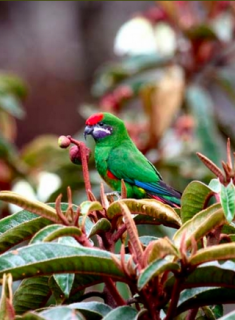Whiskered Lorikeet |
|
|
Also known as: Plum-faced Lorikeet, Plum-faced Mountain Lory
Photos
View in GalleryDid You Know?
The Whiskered Lorikeet has been seen displaying its underwing markings which may be linked to courtship. The male engages in head-bobbing as well.Academic Research
Related publications: Oreopsittacus arfakiSpecies Profile
Genus: Oreopsittacus | Species: arfaki
Size:
15cm (6 in)
Weight:
16-23g (0.5-0.8 oz)
Subspecies including nominate:
three: O.a. arfaki, O.a. major, O.a. grandis
Colour Adult:
O.a. arfaki: Both adults mainly green in colour; red forecrown; purple lores and cheeks; from lores to area below eyes are two rows of white streaks; orange/red abdomen and lower flanks; yellow on sides of undertail coverts; red underwing coverts to sides of breast; underwing stripe yellow; green tail tipped with rose/red. Bill black. Eye dark brown.
O.a. major: Larger in size than arfaki; tail has scarlet tips.
O.a. grandis: As in major, but with green on abdomen to lower flanks.
Colour Juvenile:
O.a arfaki: Frontal band red in males, orange frontal band narrower in females; green crown; dull green cheeks, with dull mauve wash; white steaks beneath eye faint.
O.a. major: As in adults.
O.a. grandis: As in adults.
Call:
Calls are described as soft, twittering notes sounding like the jangle of small coins; also repetitious, abrupt notes.
Listen NowVideo Links:
Video 1 | Video 2More Information:
Content Sources:
CITES
BirdLife International
Cornell Lab of Ornithology/Birds of the World
Parrots: A Guide to Parrots of the World, Juniper and Parr, 1998
ML Media Collection Catalogue 100631, Plum-faced Lorikeet Oreopsittacus arfaki, Mack, Andrew, Eastern Highlands, Papua New Guinea, Jan. 25 1999, Cornell Lab of Ornithology. Site
Parrots of the World, Forshaw, 2006. 2010 edition
Lexicon of Parrots, Thomas Arndt.
Photos
View in GalleryDid You Know?
The Whiskered Lorikeet has been seen displaying its underwing markings which may be linked to courtship. The male engages in head-bobbing as well.Academic Research
Related publications: Oreopsittacus arfakiSpecies Care
Captive Status:
Rare
Longevity:
Not recorded.
Housing:
Enclosure 2 x 1 x 2m (6.5 x 3 x 6.5 ft) minimum temperature 20C (68 F), with roosting box.
Diet:
Fruits such as: apple, pear, orange, banana, cactus fruits, mango, papaya, pomegranate; nectar made from: honey, pollen, brewer's yeast, oat flakes, multigrain flakes; mineral and vitamin supplements; green leaves such as: Swiss chard, lettuce, kale, sowthistle, dandelion, chickweed; additional commercial lory food during acclimatisation.
Enrichment:
Not recorded.
Nest Box Size:
Vertical box 15cm x 15cm x 40cm (6 x 6 x 15 in).
Clutch Size:
Not recorded.
Incubation Time:
Not recorded.
Fledging Age:
Not recorded.
Hatch Weight:
Not recorded.
Peak Weight:
Not recorded.
Weaning Weight:
Not recorded.
Specialist Club:
Photos
View in GalleryDid You Know?
The Whiskered Lorikeet has been seen displaying its underwing markings which may be linked to courtship. The male engages in head-bobbing as well.Academic Research
Related publications: Oreopsittacus arfakiSpecies Wild Status
World Population:
Unknown, stable.
IUCN Red List Status:
Least Concern
CITES Listing:
Appendix II
Threat Summary:
Not globally threatened. Fairly common but difficult to observe. Regularly seen around Tari Gap, Papua New Guinea.
Range:
O.a. arfaki: Mountains of Vogelkop, Irian Jaya.
O.a. major: Snow Mountains, Irian Jaya.
O.a. grandis: Mountains of SE New Guinea, west to Huon Peninsula and Victor Emanuel Range, W Papua New Guinea.
Habitat:
Found from 2000-3750m (6560-12,300 ft) in montane moss forest.
Wild Diet:
Diet includes nectar, possibly pollen of Dimorphanthera cf. cornuta, flowers and fruits of Schefflera and berries.
Ecology and Behaviour:
Most often seen in pairs or small flocks which are quite conspicuous. Forages in the canopy and mid-storey on flowers of epiphytes and often in the company of other blossom-feeders.
Clutch and Egg Size:
Not recorded.
Breeding Season:
June-October.
Photos
View in GalleryDid You Know?
The Whiskered Lorikeet has been seen displaying its underwing markings which may be linked to courtship. The male engages in head-bobbing as well.Academic Research
Related publications: Oreopsittacus arfakiMembers Only Resources
Please log-in now to find more research, resources and tools.
Not a Member?
Find more great information:
Gain exclusive access to 600+ pages of additional research, seminars and podcasts, specialists to ask your toughest questions, and dozens of other fun resources - when you become a WPT member.
Join Today >>

































